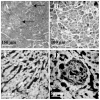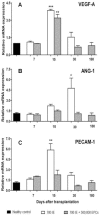Co-transplantation of endothelial progenitor cells and pancreatic islets to induce long-lasting normoglycemia in streptozotocin-treated diabetic rats
- PMID: 24733186
- PMCID: PMC3986409
- DOI: 10.1371/journal.pone.0094783
Co-transplantation of endothelial progenitor cells and pancreatic islets to induce long-lasting normoglycemia in streptozotocin-treated diabetic rats
Abstract
Graft vascularization is a crucial step to obtain stable normoglycemia in pancreatic islet transplantation. Endothelial progenitor cells (EPCs) contribute to neoangiogenesis and to the revascularization process during ischaemic events and play a key role in the response to pancreatic islet injury. In this work we co-transplanted EPCs and islets in the portal vein of chemically-induced diabetic rats to restore islet vascularization and to improve graft survival. Syngenic islets were transplanted, either alone or with EPCs derived from green fluorescent protein (GFP) transgenic rats, into the portal vein of streptozotocin-induced diabetic rats. Blood glucose levels were monitored and intraperitoneal glucose tolerance tests were performed. Real time-PCR was carried out to evaluate the gene expression of angiogenic factors. Diabetic-induced rats showed long-lasting (6 months) normoglycemia upon co-transplantation of syngenic islets and EPCs. After 3-5 days from transplantation, hyperglycaemic levels dropped to normal values and lasted unmodified as long as they were checked. Further, glucose tolerance tests revealed the animals' ability to produce insulin on-demand as indexed by a prompt response in blood glucose clearance. Graft neovascularization was evaluated by immunohistochemistry: for the first time the measure of endothelial thickness revealed a donor-EPC-related neovascularization supporting viable islets up to six months after transplant. Our results highlight the importance of a newly formed viable vascular network together with pancreatic islets to provide de novo adequate supply in order to obtain enduring normoglycemia and prevent diabetes-related long-term health hazards.
Conflict of interest statement
Figures






Similar articles
-
Recovery of pancreatic beta cells in response to long-term normoglycemia after pancreas or islet transplantation in severely streptozotocin diabetic adult rats.Pancreas. 2001 Aug;23(2):186-96. doi: 10.1097/00006676-200108000-00009. Pancreas. 2001. PMID: 11484921
-
The effect of fibroblast activation on vascularization in transplanted pancreatic islets.J Surg Res. 2013 Jul;183(1):450-6. doi: 10.1016/j.jss.2012.12.044. Epub 2013 Jan 20. J Surg Res. 2013. PMID: 23369362
-
Bone marrow-derived mesenchymal stem cells improve islet graft function in diabetic rats.Transplant Proc. 2009 Jun;41(5):1797-800. doi: 10.1016/j.transproceed.2008.11.015. Transplant Proc. 2009. PMID: 19545731
-
Engineering the vasculature for islet transplantation.Acta Biomater. 2019 Sep 1;95:131-151. doi: 10.1016/j.actbio.2019.05.051. Epub 2019 May 23. Acta Biomater. 2019. PMID: 31128322 Free PMC article. Review.
-
Revascularization of transplanted pancreatic islets and role of the transplantation site.Clin Dev Immunol. 2013;2013:352315. doi: 10.1155/2013/352315. Epub 2013 Sep 9. Clin Dev Immunol. 2013. PMID: 24106517 Free PMC article. Review.
Cited by
-
The role of endothelial cells on islet function and revascularization after islet transplantation.Organogenesis. 2016 Jan 2;12(1):28-32. doi: 10.1080/15476278.2016.1165378. Epub 2016 Mar 22. Organogenesis. 2016. PMID: 27002241 Free PMC article.
-
Melittin inhibits tumor angiogenesis modulated by endothelial progenitor cells associated with the SDF-1α/CXCR4 signaling pathway in a UMR-106 osteosarcoma xenograft mouse model.Mol Med Rep. 2016 Jul;14(1):57-68. doi: 10.3892/mmr.2016.5215. Epub 2016 May 6. Mol Med Rep. 2016. PMID: 27177128 Free PMC article.
-
No Time to Die-How Islets Meet Their Demise in Transplantation.Cells. 2023 Mar 3;12(5):796. doi: 10.3390/cells12050796. Cells. 2023. PMID: 36899932 Free PMC article. Review.
-
Erythropoietin accelerates the revascularization of transplanted pancreatic islets.Br J Pharmacol. 2020 Apr;177(7):1651-1665. doi: 10.1111/bph.14925. Epub 2020 Feb 10. Br J Pharmacol. 2020. PMID: 31721150 Free PMC article.
-
Recapitulating pancreatic cell-cell interactions through bioengineering approaches: the momentous role of non-epithelial cells for diabetes cell therapy.Cell Mol Life Sci. 2021 Dec;78(23):7107-7132. doi: 10.1007/s00018-021-03951-2. Epub 2021 Oct 6. Cell Mol Life Sci. 2021. PMID: 34613423 Free PMC article. Review.
References
-
- Ryan EA, Paty BW, Senior PA, Bigam D, Alfadhli E, et al. (2005) Five-year follow-up after clinical islet transplantation. Diabetes 54: 2060–2069. - PubMed
-
- Shapiro AM, Lakey JR (2000) Future trends in islet cell transplantation. Diabetes Technol Ther 2: 449–452. - PubMed
-
- Bonner-Weir S, Orci L (1982) New perspectives on the microvasculature of the islets of Langerhans in the rat. Diabetes 31: 883–889. - PubMed
-
- Jansson L (1994) The regulation of pancreatic islet blood flow. Diabetes Metab Rev 10: 407–416. - PubMed
-
- Murakami T, Fujita T (1992) Microcirculation of the rat pancreas, with special reference to the insulo-acinar portal and insulo-venous drainage systems: a further scanning electron microscope study of corrosion casts. Arch Histol Cytol 55: 453–476. - PubMed
Publication types
MeSH terms
Substances
LinkOut - more resources
Full Text Sources
Other Literature Sources
Medical

